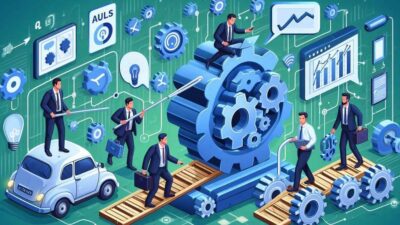
In the evolving world of modern sales, AI and human sales are no longer separate forces, they’re a winning duo. As sales cycles grow more complex and buyers more informed, combining AI’s data-driven intelligence with human intuition is the key to staying ahead. This powerful partnership helps teams work smarter, engage prospects more effectively, and ultimately, close deals faster and more consistently.
The Rise of the Hybrid Sales Force
The most successful sales organizations of 2025 aren’t choosing between humans and AI they’re combining them strategically. When implemented correctly, AI handles repetitive tasks and data analysis, while sales reps focus on relationship-building and complex negotiations. This synergy leads to 28% higher win rates and 40% more rep productivity, according to Salesforce research.
However, poor integration can backfire. Teams that simply “bolt on” AI without rethinking workflows often see resistance from reps and subpar ROI. This guide explores proven strategies to create a seamless human-AI partnership that drives revenue growth.
Define Clear Roles: What AI Should (and Shouldn’t) Do
AI’s Strengths
✔ **Data processing**: Analyzing 1000s of calls/emails for patterns
✔ **Administration**: Logging activities, updating CRMs
✔ **Lead prioritization**: Scoring and routing prospects
✔ **Real-time coaching**: Suggesting responses during calls
Human Strengths
✔ **Relationship building**: Emotional intelligence in negotiations
✔ **Creative problem-solving**: Tailoring solutions to unique needs
✔ **High-stakes decisions**: Final pricing, contract terms
Best Practice:
Create a RACI matrix (Responsible, Accountable, Consulted, Informed) for AI vs. human tasks. Example:
| Task | AI Role | Human Role |
| Lead qualification | Scores prospects | Handles high-touch leads |
| Email outreach | Drafts initial emails | Personalizes key messages |
| Deal forecasting | Predicts outcomes | Makes final judgment |
Optimize Your Tech Stack for Seamless Handoffs
The biggest friction point occurs when AI and humans **fail to share context**. Solutions:
CRM Integration
- Ensure AI tools (e.g., Gong, Clari) push insights directly into Salesforce/HubSpot
- Use Clearbit or ZoomInfo to auto-enrich records
Communication Protocols
- AI chatbots should pass conversation history when escalating to humans
- Implement Shared Inboxes (e.g., Front) for AI-human email collaboration
Case Study: A fintech company reduced response time by 65% after connecting their AI chatbot to Slack alerts for sales reps.
Train Teams to Work With AI (Not Against It)
For Sales Reps
- Frame AI as an assistant: “This handles admin so you can focus on selling”
- Show concrete benefits: Demo how AI saves 5+ hours/week on data entry
- Address fears head-on: “AI won’t replace you—but reps using AI will replace those who don’t”
For Managers
- Co-create playbooks: Blend AI insights with human expertise
- Track augmentation metrics: % of deals where AI suggestions were used/ignored
Run AI adoption sprints with rewards for reps who achieve the most AI-assisted wins.
Balance Automation With Human Touchpoints
When to Use AI
- First touch (chatbots, automated emails)
- Routine follow-ups
- Data-heavy tasks (contract review, compliance checks)
When to Use Humans
- Final negotiations
- Executive-level conversations
- Complex objection handling
Example Workflow:
- AI chatbot qualifies lead → 2. AI schedules meeting → 3. Human rep conducts demo → 4. AI sends follow-up materials
Measure What Matters: Hybrid Performance Metrics
Track both individual and AI-influenced KPIs:
| Metric | Human Focus | AI Contribution |
| Response time | <2 hrs for hot leads | AI handles 80% of initial replies |
| Win rate | Rep’s closing skills | AI’s lead scoring accuracy |
| Deal size | Negotiation ability | AI’s upsell recommendations |
Tool Suggestion: Use Tableau or Power BI to visualize how AI impacts pipeline velocity.
Address Ethical Considerations Proactively
Bias Prevention
- Audit AI models for demographic bias in lead scoring
- Maintain human oversight for sensitive decisions
Transparency
- Disclose AI use to customers when appropriate
- Let reps override AI recommendations with documented reasons
Compliance Checklist:
☑ GDPR/CCPA compliance for AI data processing
☑ Recordkeeping for AI-driven pricing decisions
Implementation Roadmap: 60 Days to Success
Weeks 1-2: Assess & Align
- Interview reps about pain points AI could solve
- Identify 1-2 high-impact use cases (e.g., call analytics)
Weeks 3-4: Pilot
- Train a small team on selected AI tools
- Document workflows and early wins
Weeks 5-8: Scale & Optimize
- Roll out to full team with customized playbooks
- Set up hybrid performance dashboards
The Future: Where Human-AI Collaboration Is Headed
🔹 **Emotional AI**: Systems that detect and adapt to customer moods
🔹 **Generative Co-Pilots**: AI that drafts proposals with human oversight
🔹 **Predictive Pairing**: Algorithms matching reps to prospects based on compatibility
Early adopters report 2x faster onboarding for new hires using AI mentors.
Conclusion:
The highest-performing sales teams treat AI as a **force multiplier**, not a replacement. By clearly defining roles, optimizing handoffs, and measuring collaborative outcomes, organizations achieve:
✅ 30-50% higher rep productivity
✅ 20% shorter sales cycles
✅ 15% increase in deal sizes




